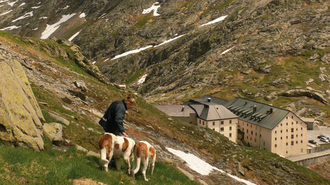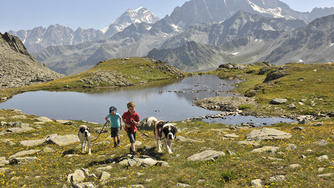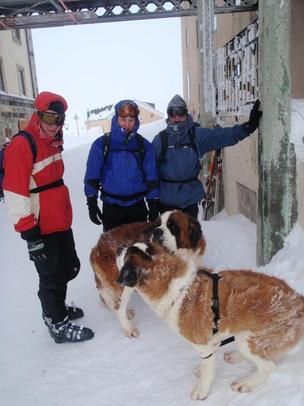HISTORY OF THE SAINT BERNARD
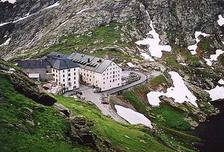
The foundation of the Saint Bernard breed is firmly embedded in the history of the mountain pass and the monastery of the same name. The Great Saint Bernard Pass that links Switzerland and Italy has a rich past, the history of which has been documented back to 57 B.C. when Caesar attempted to conquer alpine tribes to ensure safe passage over the Alps during the Gallic wars. During subsequent years, Roman Emperors Augustus and Claudius made substantial improvements to the route over the pass and it was given the rank of an imperial road. It was at this time that a small temple in honour of Jupiter (Jovis) was built on top of the pass at 2464m with a small "mansio" to accommodate travellers and the mountain was renamed "Mons Jovis."
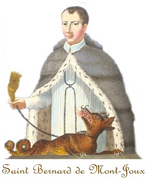
The Hospice and congregation were founded in the eleventh century by St Bernard de Montjoux (also known as St Bernard of Menthon), Archdeacon in the City of Aosta, (canonized in 1123). On becoming apparent it required a reliable income, a complete list of all donations to the monastery commenced in 1125. It is recorded that Pope Alexander III placed the monastery under papal shelter in 1177 at which time the monastery's assets enumerated around 80 estates from Sicily, France, Switzerland and England. Having waned in significance somewhat, the following four hundred years saw the pass at Mont-Joux, as it was then known, regain its importance and the monastery grew to the size we see today. It was during the sixteenth century that the pass and the monastery were given the name of Saint Bernard.
It is thought that dogs were probably first kept at the Hospice around 1660 and 1670 with their initial purpose as watch dogs against marauders as this was a common path of pilgrimage for those journeying to Rome through the mountains between Italy and Switzerland. It was well known as a most inhospitable route through the mountains due to the weather and thieves so respite offered was gratefully received by pilgrims and travellers.
It is thought that dogs were probably first kept at the Hospice around 1660 and 1670 with their initial purpose as watch dogs against marauders as this was a common path of pilgrimage for those journeying to Rome through the mountains between Italy and Switzerland. It was well known as a most inhospitable route through the mountains due to the weather and thieves so respite offered was gratefully received by pilgrims and travellers.
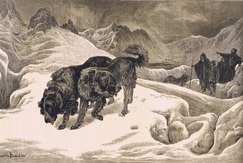
The artist Salvatore Rosa painted two dogs from the Hospice around 1690 whilst the first written references to dogs at the Hospice date from 1703 and are nearly always described being large but would be relatively smaller than that of modern Saint Bernard. It is also reported that M J Bourrit an artist from Geneva wrote about the monks and their rescue dogs in 1774.
The more successful their rescue work became coupled with the decrease in accidents resulted in the their reputation spreading far and wide. With an excellent sense of direction, an acute ability to navigate through dense fog, snow storms and to warn of an impending avalanche, the dogs always accompanied the monks or marroniers on treks. But the dogs later did make expeditions on their own in small packs of two or three to search for travellers buried in after an avalanche or snow storm. The dogs would often dig through metres of snow and ice and if found alive the traveller would be kept warm, conscious and comforted by one dog one whilst the other would return to the Hospice to raise the alarm. Over the approximated 200 years that the Saint Bernard dogs worked on the Pass it is estimated that 2000 people were rescued. The last rescue recorded was of a 12 year old boy who was nearly frozen to death and found in a crevice and was awakened by a Saint Bernard dog in 1897.
Of all the dogs Barry is the most famous Saint Bernard to have lived and worked at the Hospice. It is claimed that he saved 40 or more people during his life however some question this figure as the monks kept no records. Tending to the needs of travellers was an everyday event and detailed records of rescues made with or without the assistance of dogs were not deemed necessary. Barry was brought to Berne by a monk in 1812 where he died two years late aged 14. He is honoured to this day with always having one dog kept at the Hospice in his namesake. No other Saint Bernard has received the notoriety or equalled the number of rescues as those made by the legendary Barry.
The more successful their rescue work became coupled with the decrease in accidents resulted in the their reputation spreading far and wide. With an excellent sense of direction, an acute ability to navigate through dense fog, snow storms and to warn of an impending avalanche, the dogs always accompanied the monks or marroniers on treks. But the dogs later did make expeditions on their own in small packs of two or three to search for travellers buried in after an avalanche or snow storm. The dogs would often dig through metres of snow and ice and if found alive the traveller would be kept warm, conscious and comforted by one dog one whilst the other would return to the Hospice to raise the alarm. Over the approximated 200 years that the Saint Bernard dogs worked on the Pass it is estimated that 2000 people were rescued. The last rescue recorded was of a 12 year old boy who was nearly frozen to death and found in a crevice and was awakened by a Saint Bernard dog in 1897.
Of all the dogs Barry is the most famous Saint Bernard to have lived and worked at the Hospice. It is claimed that he saved 40 or more people during his life however some question this figure as the monks kept no records. Tending to the needs of travellers was an everyday event and detailed records of rescues made with or without the assistance of dogs were not deemed necessary. Barry was brought to Berne by a monk in 1812 where he died two years late aged 14. He is honoured to this day with always having one dog kept at the Hospice in his namesake. No other Saint Bernard has received the notoriety or equalled the number of rescues as those made by the legendary Barry.
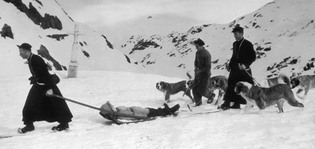
The colour of the Hospice dogs was typically red-brown and white which was wide-spread among farm dogs in Switzerland and was the singular recognizable characteristic of the Saint Bernard. Therefore as the need arose the monks did not find it difficult to replenish their pack from local stock and given their isolation for long periods throughout the year specific types for that or any given area evolved swiftly.
The picture left depicts Monks and a team of St Bernard's rescue a lost traveller in the Swiss Alps, circa 1955. Photo by George Pickow/Three Lions/Hulton Archive/Getty Images.
The Natural History Museum in Berne reports that: " Max Siber writes in the Swiss Stud Book #1 of 1884: "some fanciers believe that Saint Bernards have only lived on the name giving Pass. This is not true, Saints have been kept everywhere on Swiss passes and they are even at home in the valleys of the Valais and in the countryside of Berne." One can also cite another expert on Saint Bernards, Albert Heim, who wrote in 1927: "Talhund und Hospizhund waren und sind die gleiche Rasse" translated "Valley dogs and dogs from the Hospice were and still are of the same breed" ".
It is purported that in order to introduce the long hair variety to the breed that Newfoundlands were crossbred with the Saint Bernard in 1830 and that this crossbreeding also possibly continued with the Pyrenean Mountain Dog and Leonberger. However there is no written evidence supporting this at the Hospice nor in an essay presented by Dr E Schmid at the 75th anniversary of the Swiss Saint Bernard Club in 1856. Today's genetic technology would be able to put this question to rest once and for all. And when the long haired dogs were found unsuitable for rescue work (the snow and ice weighed their coats down) they were given to patrons in the valleys. It was not long before popular belief had the Saint Bernard always having had a long coat and thus was looked upon more favourably of the two varieties.
The picture left depicts Monks and a team of St Bernard's rescue a lost traveller in the Swiss Alps, circa 1955. Photo by George Pickow/Three Lions/Hulton Archive/Getty Images.
The Natural History Museum in Berne reports that: " Max Siber writes in the Swiss Stud Book #1 of 1884: "some fanciers believe that Saint Bernards have only lived on the name giving Pass. This is not true, Saints have been kept everywhere on Swiss passes and they are even at home in the valleys of the Valais and in the countryside of Berne." One can also cite another expert on Saint Bernards, Albert Heim, who wrote in 1927: "Talhund und Hospizhund waren und sind die gleiche Rasse" translated "Valley dogs and dogs from the Hospice were and still are of the same breed" ".
It is purported that in order to introduce the long hair variety to the breed that Newfoundlands were crossbred with the Saint Bernard in 1830 and that this crossbreeding also possibly continued with the Pyrenean Mountain Dog and Leonberger. However there is no written evidence supporting this at the Hospice nor in an essay presented by Dr E Schmid at the 75th anniversary of the Swiss Saint Bernard Club in 1856. Today's genetic technology would be able to put this question to rest once and for all. And when the long haired dogs were found unsuitable for rescue work (the snow and ice weighed their coats down) they were given to patrons in the valleys. It was not long before popular belief had the Saint Bernard always having had a long coat and thus was looked upon more favourably of the two varieties.
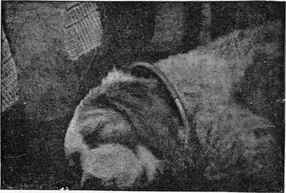
*Headshot of St Bernard, Barry I
It is purported that in order to introduce the long hair variety to the breed that Newfoundlands were crossbred with the Saint Bernard in 1830 and that this crossbreeding also possibly continued with the Pyrenean Mountain Dog and Leonberger. However there is no written evidence supporting this at the Hospice nor in an essay presented by Dr E Schmid at the 75th anniversary of the Swiss Saint Bernard Club in 1856. Today's genetic technology would be able to put this question to rest once and for all. And when the long haired dogs were found unsuitable for rescue work (the snow and ice weighed their coats down) they were given to patrons in the valleys. It was not long before popular belief had the Saint Bernard always having had a long coat and thus was looked upon more favourably of the two varieties.
It is reported that Count v. Rougemont gave a short-haired dog that originated from the Hospice to Mr Klopfenstein in Neuenegg who then sold him to Heinrich Schumacher in 1855. Barry I as he was named was an important foundation stud dog in Schumacher's kennel who was the first person to establish the use of a stud book (first Swiss Stud Book, 1884), thus creating accurate record of pedigrees. In 1862, he began shipping Saint Bernard dogs to England, Russia and the United States of America. Schumacher's breeding programme was rewarded when he produced the famous Favorita I who together with Sultan I won the first prize at the 1867 World Fair in Paris.
It is believed that Schumacher who retained strong ties with the monks at the Hospice aimed to maintain an ideal embodied in the old Barry type whilst other breeders found favour in heavy heads, strong stops and short muzzles. After a number a years of indiscriminate breeding by some breeders and also what can be described as confusion about the breed in general, the Swiss Standard was introduced in 1887 following which a degree of order prevailed. Swiss breeders were upheld as the authority through conformation to the Swiss Standard and ironically the Hospice ignored the Swiss Standard entirely. Schumacher retired from breeding in 1890.
The Picture right is *Headshot of St Bernard, Barry I from "British Dogs, Their Points, Selection, And Show Preparation", by W. D. Drur
It is reported that Count v. Rougemont gave a short-haired dog that originated from the Hospice to Mr Klopfenstein in Neuenegg who then sold him to Heinrich Schumacher in 1855. Barry I as he was named was an important foundation stud dog in Schumacher's kennel who was the first person to establish the use of a stud book (first Swiss Stud Book, 1884), thus creating accurate record of pedigrees. In 1862, he began shipping Saint Bernard dogs to England, Russia and the United States of America. Schumacher's breeding programme was rewarded when he produced the famous Favorita I who together with Sultan I won the first prize at the 1867 World Fair in Paris.
It is believed that Schumacher who retained strong ties with the monks at the Hospice aimed to maintain an ideal embodied in the old Barry type whilst other breeders found favour in heavy heads, strong stops and short muzzles. After a number a years of indiscriminate breeding by some breeders and also what can be described as confusion about the breed in general, the Swiss Standard was introduced in 1887 following which a degree of order prevailed. Swiss breeders were upheld as the authority through conformation to the Swiss Standard and ironically the Hospice ignored the Swiss Standard entirely. Schumacher retired from breeding in 1890.
The Picture right is *Headshot of St Bernard, Barry I from "British Dogs, Their Points, Selection, And Show Preparation", by W. D. Drur
The Saint Bernard and The Kegs
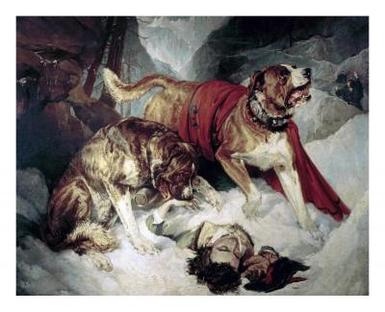
The legend began with the painting was entitled: ‘Alpine Mastiffs Reanimating a Distressed Traveller’ by Sir Edwin Henry Landseer. One of the Saint Bernards in the picture is seen carrying a wooden keg or barrel from its collar.
Whilst some maintain that the dogs did carry these kegs or barrels, it is widely agreed that the dogs did not. However there is evidence that they did carry packs with supplies for lost travellers.
Picture Left: ‘Alpine Mastiffs Reanimating a Distressed Traveller’
by Sir Edwin Henry Landseer.
The Saints at Grand St Bernard Today
For Summer and Winter activities with the Saints at The Pass or at Martigny please contact Fondation Barry du Grand St Bernard at http://www.fondation-barry.ch/en
An interesting and affecting story is told of two of these brave dogs having once saved the life of a little boy who had lost his way on the mountain.
THE LOST CHILD
By Anon
A Short Story: Dog of St. Bernard
A Short Story: Dog of St. Bernard
|
I It was a clear, cold, winter night, The heavens all brightly starred, Where on Mount Bernard’s snowy height The good monks kept their guard. And round their hearth, that night, they told To one who shelter craved, How the brave dog, he thought so old, Full forty lives had saved; When, suddenly, with kindling eye, Up sprang the old dog there, As from afar a child’s shrill cry Rung through the frosty air. In haste the monks unbarred the door, Rugs round the mastiffs threw; And as they bounded forth once more, Called, “Blessings be with you!” II They hurried headlong down the hill, Past many a snow-wreath wild, Until the older guide stood still Beside a sleeping child. He licked the little icy hand With his rough, kindly tongue; With his warm breath he gently fanned The tresses fair and long. The child looked up, with eyes of blue, As if the whole he guessed; His arms around the dog he threw, And sunk again to rest. Once more he woke, and wrapped him fast In the warm covering sent; The dogs then with their charge, at last, Up the steep mountain went. |
III The fire glowed bright with heaped-up logs, Each monk brought forth a light; “Good dogs!” they cried, “good dogs, good dogs! Whom bring you here to-night?” In, with a joyous bound, they come-- The boy awoke and smiled: “Ah me!” the stranger cried, “some home Mourneth for thee, fair child!” With morning light, the monks and boy Sought where the village lay-- I dare not try to paint the joy Their coming gave that day. “If sweet,” the brethren said, “to see Such gladness shed around, What wondrous joy in Heaven must be, When a lost child is found!” |
